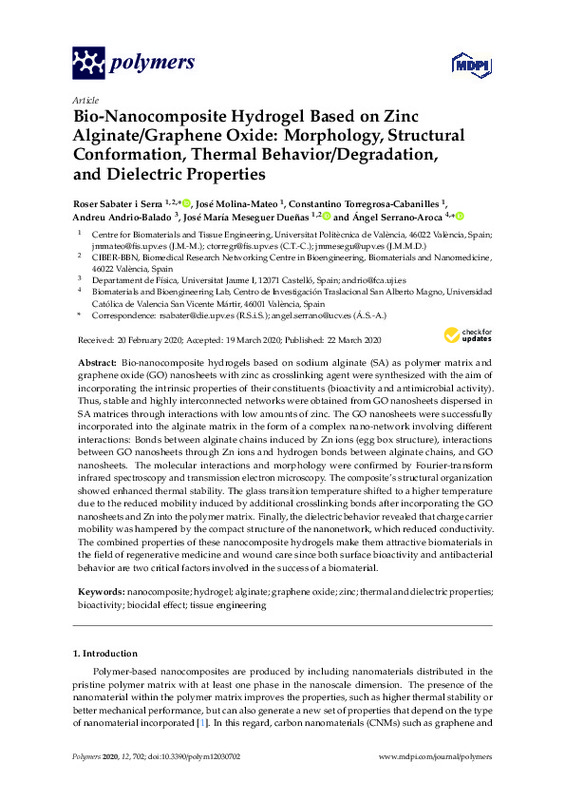JavaScript is disabled for your browser. Some features of this site may not work without it.
Buscar en RiuNet
Listar
Mi cuenta
Estadísticas
Ayuda RiuNet
Admin. UPV
Bio-Nanocomposite Hydrogel Based on Zinc Alginate/Graphene Oxide: Morphology, Structural Conformation, Thermal Behavior/Degradation, and Dielectric Properties
Mostrar el registro sencillo del ítem
Ficheros en el ítem
| dc.contributor.author | Sabater i Serra, Roser
|
es_ES |
| dc.contributor.author | Molina Mateo, José
|
es_ES |
| dc.contributor.author | Torregrosa Cabanilles, Constantino
|
es_ES |
| dc.contributor.author | Andrio-Balado, Andreu
|
es_ES |
| dc.contributor.author | Meseguer Dueñas, José María
|
es_ES |
| dc.contributor.author | Serrano-Aroca, Ángel
|
es_ES |
| dc.date.accessioned | 2021-11-05T14:08:51Z | |
| dc.date.available | 2021-11-05T14:08:51Z | |
| dc.date.issued | 2020-03 | es_ES |
| dc.identifier.uri | http://hdl.handle.net/10251/176347 | |
| dc.description.abstract | [EN] Bio-nanocomposite hydrogels based on sodium alginate (SA) as polymer matrix and graphene oxide (GO) nanosheets with zinc as crosslinking agent were synthesized with the aim of incorporating the intrinsic properties of their constituents (bioactivity and antimicrobial activity). Thus, stable and highly interconnected networks were obtained from GO nanosheets dispersed in SA matrices through interactions with low amounts of zinc. The GO nanosheets were successfully incorporated into the alginate matrix in the form of a complex nano-network involving different interactions: Bonds between alginate chains induced by Zn ions (egg box structure), interactions between GO nanosheets through Zn ions and hydrogen bonds between alginate chains, and GO nanosheets. The molecular interactions and morphology were confirmed by Fourier-transform infrared spectroscopy and transmission electron microscopy. The composite's structural organization showed enhanced thermal stability. The glass transition temperature shifted to a higher temperature due to the reduced mobility induced by additional crosslinking bonds after incorporating the GO nanosheets and Zn into the polymer matrix. Finally, the dielectric behavior revealed that charge carrier mobility was hampered by the compact structure of the nanonetwork, which reduced conductivity. The combined properties of these nanocomposite hydrogels make them attractive biomaterials in the field of regenerative medicine and wound care since both surface bioactivity and antibacterial behavior are two critical factors involved in the success of a biomaterial. | es_ES |
| dc.description.sponsorship | This research was funded by the Spanish Ministry of Science, Innovations and Universities through the RTI2018-097862-B-C21 Project (including the FEDER financial support). A.S.-A. also acknowledges the Fundacion Universidad Catolica de Valencia San Vicente Martir though Grant No 2019-231-003UCV. CIBER-BBN (Centro de Investigacion Biomedica en Red, Bioingenieria, Biomateriales y Nanomedicina) is an initiative funded by the VI National R&D&I Plan 2008-2011, Iniciativa Ingenio 2010, Consolider Program. CIBER Actions are financed by the Instituto de Salud Carlos III with assistance from the European Regional Development Fund. | es_ES |
| dc.language | Inglés | es_ES |
| dc.publisher | MDPI AG | es_ES |
| dc.relation.ispartof | Polymers | es_ES |
| dc.rights | Reconocimiento (by) | es_ES |
| dc.subject | Nanocomposite | es_ES |
| dc.subject | Hydrogel | es_ES |
| dc.subject | Alginate | es_ES |
| dc.subject | Graphene oxide | es_ES |
| dc.subject | Zinc | es_ES |
| dc.subject | Thermal and dielectric properties | es_ES |
| dc.subject | Bioactivity | es_ES |
| dc.subject | Biocidal effect | es_ES |
| dc.subject | Tissue engineering | es_ES |
| dc.subject.classification | INGENIERIA ELECTRICA | es_ES |
| dc.subject.classification | FISICA APLICADA | es_ES |
| dc.title | Bio-Nanocomposite Hydrogel Based on Zinc Alginate/Graphene Oxide: Morphology, Structural Conformation, Thermal Behavior/Degradation, and Dielectric Properties | es_ES |
| dc.type | Artículo | es_ES |
| dc.identifier.doi | 10.3390/polym12030702 | es_ES |
| dc.relation.projectID | info:eu-repo/grantAgreement/UCV//2019-231-003UCV/ | es_ES |
| dc.relation.projectID | info:eu-repo/grantAgreement/ISCIII//CIBER-BBN/ | es_ES |
| dc.relation.projectID | info:eu-repo/grantAgreement/AEI//RTI2018-097862-B-C21-AR//MICROENTORNOS BIOACTIVOS, ELECTROCONDUCTIVOS Y ANTIMICROBIANOS CON CAPACIDAD DE ESTIMULAR LA REGENERACION OSEA Y PREVENIR INFECCIONES MULTIRRESISTENTES/ | es_ES |
| dc.rights.accessRights | Abierto | es_ES |
| dc.contributor.affiliation | Universitat Politècnica de València. Departamento de Ingeniería Eléctrica - Departament d'Enginyeria Elèctrica | es_ES |
| dc.contributor.affiliation | Universitat Politècnica de València. Departamento de Física Aplicada - Departament de Física Aplicada | es_ES |
| dc.description.bibliographicCitation | Sabater I Serra, R.; Molina Mateo, J.; Torregrosa Cabanilles, C.; Andrio-Balado, A.; Meseguer Dueñas, JM.; Serrano-Aroca, Á. (2020). Bio-Nanocomposite Hydrogel Based on Zinc Alginate/Graphene Oxide: Morphology, Structural Conformation, Thermal Behavior/Degradation, and Dielectric Properties. Polymers. 12(3):1-16. https://doi.org/10.3390/polym12030702 | es_ES |
| dc.description.accrualMethod | S | es_ES |
| dc.relation.publisherversion | https://doi.org/10.3390/polym12030702 | es_ES |
| dc.description.upvformatpinicio | 1 | es_ES |
| dc.description.upvformatpfin | 16 | es_ES |
| dc.type.version | info:eu-repo/semantics/publishedVersion | es_ES |
| dc.description.volume | 12 | es_ES |
| dc.description.issue | 3 | es_ES |
| dc.identifier.eissn | 2073-4360 | es_ES |
| dc.identifier.pmid | 32235735 | es_ES |
| dc.identifier.pmcid | PMC7183265 | es_ES |
| dc.relation.pasarela | S\408140 | es_ES |
| dc.contributor.funder | Instituto de Salud Carlos III | es_ES |
| dc.contributor.funder | AGENCIA ESTATAL DE INVESTIGACION | es_ES |
| dc.contributor.funder | European Regional Development Fund | es_ES |
| dc.contributor.funder | Universidad Católica de Valencia San Vicente Mártir | es_ES |
| dc.subject.ods | 03.- Garantizar una vida saludable y promover el bienestar para todos y todas en todas las edades | es_ES |








